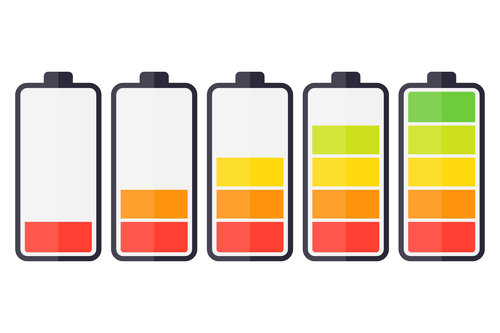The 4 Types of Rechargeable Batteries Explained

Need a reliable and rechargeable power source for a device, innovation, or engineering project? Do you know which type of rechargeable battery you need?
Below is the ultimate guide on rechargeable battery types. In it, you'll learn the four most common types of rechargeable batteries and a few less popular types as well. We'll compare how well these rechargeable batteries perform, detailing the pros and cons of each type.
From this information, you'll be able to decide which type of battery is best for your needs. Read on to learn all you need to know about rechargeable battery types.
1. Lead-Acid Batteries
Lead-acid batteries are the oldest type of rechargeable battery, dating all the way back to the 1850s! And yet, they're still a great option today for many reasons.
They're very powerful, hardy, and cheap. And they last for a long time, too—3 to 5 years. Because they are so powerful, they are mostly used in electric vehicles, like wheelchairs and golf carts.
Unfortunately, they obviously contain lead, a notorious toxin. This being the case, they are very bad for the planet if not properly disposed of. They must be taken to a recycling centre that accepts them and never simply thrown out.
2. Nickel-Cadmium (NiCd) Batteries
NiCd batteries are another powerful (and old) choice in that they can supply a very high electrical current—ideal for high-drain devices like cameras. However, they have a very low capacity (that is, they don't hold a charge for very long). Because of this, they are not considered so ideal these days.
Of course, their low capacity also means they reach a full charge very quickly when charging. For all these reasons, they are still ideal for things like portable power tools and medical devices. These tools are powerful but only used in short increments and can recharge fast between uses.
Another drawback, though, is that cadmium, like lead, is also toxic. The good news is, you rarely have to discard them. They last 10-15 years or longer and are extremely hardy, even against extreme temperatures.
3. Nickel-Metal Hydride (NiMH) Batteries
More good news: NiMH batteries eliminate the shortcomings of NiCd batteries in every way, except for their lifespan. NiMH batteries last up to 1000 charges (about 3 years maximum).
Still, they work just as well for high-drain devices as NiCd batteries and they have a far better capacity. Plus, they don't contain toxic cadmium, only mildly toxic metals.
They also have a high self-discharge rate, meaning they quickly lose energy when not in use. Luckily, you can buy the low self-discharge (LSD) version of these batteries to sidestep this. The LSD NiMH batteries have a slightly lower capacity, but they're worth it.
4. Lithium-Ion (Li-ion) Batteries
Li-ion is the most common type of rechargeable battery used in portable electronic devices today. They're light, put out a very high voltage, and last around 3 years (300-500 charges).
Most importantly, they hold a charge longer than any other battery type on this list, whether idle or in use. This also makes them the most expensive.
However, because they contain a flammable electrolyte, they do pose a potential danger. This, in fact, is the reason for the Samsung Galaxy Note 7 fires and subsequent recall. For this reason, Li-ion batteries require a safety circuit.
Other Types of Rechargeable Batteries
Beyond these common types, here are a few other types of rechargeable batteries worth mentioning. They may be useful in upcoming projects that you have.
Nickel-Zinc (NiZn) Batteries
NiZn batteries were created as an alternative to NiMH batteries. Thus, they are comparable in most respects.
Both are best for high-drain devices and are non-toxic. And they both have a high self-discharge rate.
The main difference between the two is that NiZn batteries have a higher voltage than NiMH. This makes them better than NiMH for certain devices, especially lighting devices.
The higher voltage can light flashbulbs and other lights shine brighter. However, this may also cause such bulbs to burn out faster.
Lithium-Ion Polymer (LiPo) Batteries
Lithium-ion polymer (or simply lithium polymer or LiPo) batteries are a newer alternative to Li-ion. They are comparable to Li-ion in lifespan and temperature resistance but superior in their capacity. They are also safer in that they are not a fire hazard.
But they're more expensive to produce than Li-ion batteries. And they have a lower energy density. That means that a LiPo battery is bulkier than a Li-ion battery that produces the same amount of energy.
In other words, LiPo is not a good choice for slim devices that are made to fit in your pocket. But, if charge life is more important to you than size and price, LiPo is a clear choice.
Alkaline Batteries
We're all familiar with alkaline batteries. These are the standard AA, AAA, C, D, etc. batteries that power most non-rechargeable battery-powered devices.
Though they've never been popular, there are rechargeable versions of alkaline batteries. Even better, they are available in all standard alkaline battery sizes. And they're manufactured by major brands like Kodak and Duracell.
It's a shame they're not very popular because they're cost-efficient compared to their disposable counterparts. At each full charge, they last about as long as a standard single-use alkaline battery.
And they last about 3 or 4 years. That's about 25-50 charge cycles (which is higher than one use). There's no doubt that rechargeable alkaline batteries pay for themselves in time.
Which Type(s) Do You Need?
After reading this comparison, have you decided which types of rechargeable batteries you need? Whatever your choice, we're positive we can help.
If you have any questions or any needs at all, just click the envelope button at the top of this screen. Then, fill out the contact form to let us know how we can help.
To learn more about different battery types, read our article here and check out the rest of our blog.
